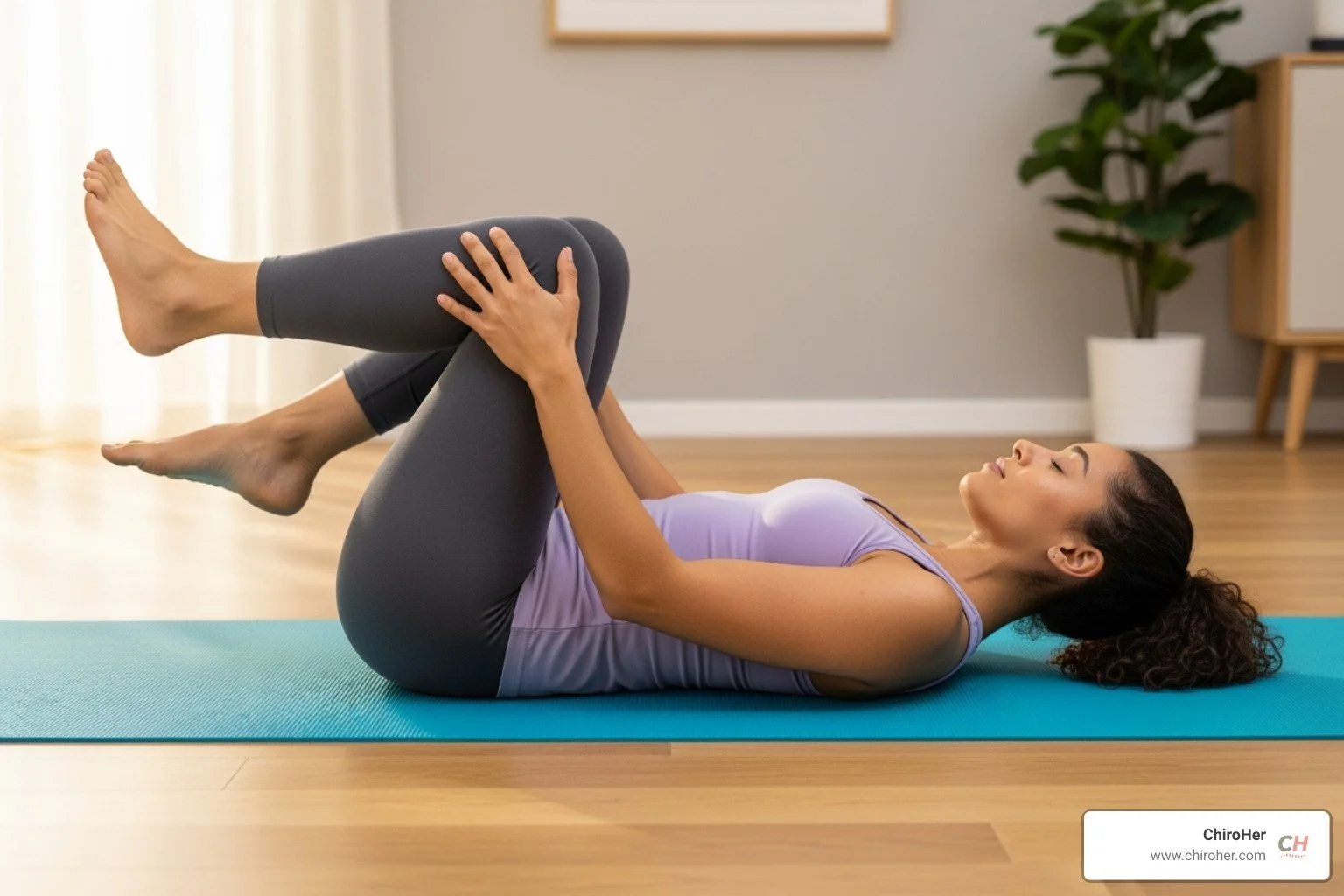Loosen Up! Sciatic Nerve Stretches to Ease Your Pain
Understanding Sciatica and How Stretching Can Help
The sharp, shooting pain of sciatica can be debilitating. It’s caused when your sciatic nerve, the body’s largest nerve, gets irritated or compressed. This nerve runs from your lower back, through your buttock, and down each leg, and when it's unhappy, you can feel intense pain, numbness, or tingling.
To quickly ease sciatica pain, try these common sciatic nerve stretches:
Knee-to-Chest Stretch: Lie on your back, pull one knee to your chest.
Figure 4 Piriformis Stretch: Lie on your back, cross one ankle over the opposite knee, gently pull towards you.
Hamstring Stretch with Towel: Lie on your back, loop a towel around your foot, gently pull your leg straight up.
Sciatic Nerve Glide: Sit on a chair, straighten one leg, gently flex your ankle up and down.
The good news is that movement often helps. Gentle stretches can release muscle tension, reduce pressure on your nerve, and improve blood flow to help your body heal. Plus, stretching can improve your posture, which can stop the pain from coming back.
Hi! I'm Dr. Michelle Andrews. As the founder of ChiroHer, a chiropractic clinic in Oklahoma City, I’ve helped many people find relief from conditions like sciatica. My expertise includes drug-free pain therapy and mobility improvement, including effective sciatic nerve stretches. I'm here to guide you through simple ways to feel better.
What is Sciatica?
Sciatica is a term for symptoms that arise when the sciatic nerve is irritated or compressed. It's not a condition itself, but a description of the radiating pain, numbness, or tingling felt along the nerve path. The sciatic nerve is the longest and thickest nerve in the body, originating from the lower spine and extending down to the toes.
Common causes for this nerve compression include:
Herniated or Slipped Disc: A disc between your vertebrae bulges and presses on a nerve root.
Spinal Stenosis: A narrowing of the spinal canal puts pressure on the nerves.
Piriformis Syndrome: A tight or spasming piriformis muscle in the buttock compresses the sciatic nerve.
Spondylolisthesis: One vertebra slips forward over another, pinching the nerve.
Degenerative Disc Disease: Age-related wear and tear on spinal discs reduces their cushioning.
Pregnancy: Added weight and hormonal changes can put pressure on the nerve.
For a deeper understanding of how issues in your lower back can lead to sciatic pain, you can find more information about Low Back Sciatic Pain. You can also explore the scientific research behind these causes through this Scientific research on sciatica causes.
Why Gentle Stretching is Your Friend
When sciatica strikes, your first instinct might be to rest, but gentle movement is a key player in finding relief. Here’s why:
Releases Muscle Tension: Stretching helps lengthen tight muscles in the lower back, buttocks, and hamstrings that can put pressure on the sciatic nerve.
Triggers Endorphins: Movement can trigger the release of endorphins, your body's natural pain relievers.
Improves Mobility: Gentle stretches restore natural movement patterns in the spine and hips, reducing stiffness and allowing the nerve to glide more freely.
Reduces Nerve Pressure: By improving flexibility and reducing tension, stretching can alleviate mechanical compression on spinal nerve roots and boost circulation to the area, which promotes healing.
Embracing gentle movement can prevent symptoms from escalating. To learn more about how movement can help alleviate your pain, check out our insights on How to Alleviate Sciatica Pain.
8 Gentle Sciatic Nerve Stretches for Relief
Here are eight sciatic nerve stretches that can help ease your discomfort. The key is patience; we are not trying to force anything or push through pain. If any stretch causes sharp or increasing pain, stop. Generally, hold each stretch for 20-30 seconds and repeat 2-3 times per side.
Foundational Supine (Lying Down) Stretches
Starting on your back takes pressure off your spine, making these stretches more comfortable.
Single Knee-to-Chest Stretch: Lie on your back with both knees bent and feet flat. Gently bring one knee toward your chest, clasping your hands behind the thigh. You'll feel a stretch in your lower back and buttock. Hold for 20-30 seconds and repeat 2-3 times per leg.
Figure-4 Piriformis Stretch: Lie on your back and cross one ankle over the opposite knee to make a figure-4 shape. Gently pull your bottom thigh toward your chest until you feel a stretch deep in your buttock and hip. Hold for 30 seconds and repeat 2-3 times per side.
Hamstring Stretch with a Towel: Lie flat with both legs extended. Loop a towel around one foot and gently pull the leg toward the ceiling, keeping it as straight as is comfortable. A slight knee bend is fine. Hold for 30 seconds and repeat 2-3 times per leg.
Lower Trunk Rotations: Lie on your back with knees bent and arms out in a T-shape. Let both knees fall gently to one side, hold for a few seconds, return to the center, then repeat on the other side. This gentle twist reduces stiffness. Repeat 10-15 times per side.
For more ways to ease sciatic nerve pain from a lying position, you can visit our page on How to Ease Sciatic Nerve Pain.
Effective Seated & Standing Stretches for Your Day
These stretches are perfect for breaking up long periods of sitting.
Seated Spinal Twist: Sit on the floor with legs extended. Bend one knee and place that foot on the outside of your straight leg. Place your opposite elbow against the bent knee and gently twist your torso, looking over your shoulder. Keep your spine long. Hold for 30-60 seconds and repeat 2-3 times per side.
Standing Hamstring Stretch: Place your heel on a low, stable surface like a chair or stair. Keep that leg straight but not locked. Hinge forward at your hips with a straight back until you feel a stretch. Hold for 30 seconds and repeat 2-3 times per leg.
Standing Piriformis Stretch: Face a wall for balance. Cross your affected leg over the knee of your standing leg in a figure-4 shape. Gently bend your standing knee and lower your hips as if sitting down. Hold for 30-60 seconds and repeat 2-3 times per side.
Cat-Cow Stretch: Start on your hands and knees. Alternate between arching your back and lifting your head (cow) and rounding your spine toward the ceiling while tucking your chin (cat). This improves spinal mobility. Perform 10-15 repetitions.
During pregnancy, sciatica can be particularly challenging. We have specific guidance on our page dedicated to Pregnancy and Sciatica Nerve.
What to Avoid: Exercises That Can Worsen Pain
Just as important as knowing what helps is understanding what might make things worse. Pain is a clear message to stop or change what you're doing. Avoid the following:
Heavy Lifting: This puts enormous strain on your lower spine. Always lift with your legs, not your back.
Certain Twisting Movements: Awkward twisting, like a golf swing, can create shearing forces on your spinal discs.
Overly Intense Stretching: A stretch should feel like a gentle pull, never a sharp pain. Back off if a stretch increases your symptoms.
Straight-Leg Sit-Ups & Double Leg Lifts: These exercises can put significant strain on your lower back.
High-Impact Activities: Running or jumping can aggravate an already irritated sciatic nerve. Opt for swimming or walking instead.
The most important rule is to listen to your body. If an exercise increases your symptoms, stop immediately.
Beyond Stretches: Prevention and Professional Care
While sciatic nerve stretches can be very effective for relief, they are one piece of the puzzle. Prevention and professional guidance help you cultivate long-term spinal health. At ChiroHer, we see sciatica as your body's way of telling you that something in your daily routine needs attention. Small changes can make a big difference.
Lifestyle Tips for Preventing Sciatica
Preventing sciatica is a crucial part of long-term spinal health. These strategies can be woven into your daily life.
Core Strengthening: Simple exercises like planks and bird-dogs act like a natural back brace, taking pressure off your lower back.
Proper Posture: When sitting, use a chair with good lower back support and keep your feet flat. When standing, distribute your weight evenly. When sleeping, try lying on your side with a pillow between your knees to support your spine.
Safe Lifting Techniques: Always bend at your knees and hips, not your back. Keep objects close to your body and never twist while lifting.
Regular Exercise: Consistent, low-impact activity like walking, swimming, or cycling keeps your muscles strong and circulation flowing.
Avoiding Prolonged Sitting: Get up and move every 30 to 60 minutes to prevent your spine from getting stiff and compressed.
For more information about how lower back issues can trigger sciatic symptoms, check out our detailed guide on Lumbago with Sciatica.
When to Stop and See a Professional
Sometimes, our bodies need professional help. Knowing when to seek care can lead to a quicker recovery. It's time to see a professional if you experience any of the following:
Severe Pain: Pain that stops you from your daily activities or doesn't improve with rest.
Worsening Symptoms: Pain, numbness, or tingling that is getting worse instead of better after a few days.
Weakness in Your Leg: Trouble lifting your foot, walking normally, or feeling like your leg is giving out.
Loss of Bladder or Bowel Control: This is a medical emergency and could indicate a rare but serious condition called Cauda Equina Syndrome.
Other Concerning Signs: Fever, chills, or night sweats along with your sciatica, or if symptoms started after a significant injury.
At ChiroHer, we understand that every woman's experience with sciatica is unique. As a boutique chiropractic clinic in Oklahoma City, we specialize in providing personalized care in a comfortable setting, with a focus on helping women and prenatal clients.
Our approach looks at the whole picture: your posture, daily activities, and overall health. We combine gentle chiropractic adjustments with acupuncture and holistic wellness services to address the root cause of your pain. We proudly serve the communities of Oklahoma City, Yukon, Edmond, Nichols Hills, Del City, Mustang, and Moore.
To learn more about how chiropractic care can specifically help with sciatica, visit our page on Chiropractor Help with Sciatica. Ready to take the next step? You can Book a Consultation with us today.
This guide is for informational purposes and is not a substitute for already established medical advice from your healthcare provider.





